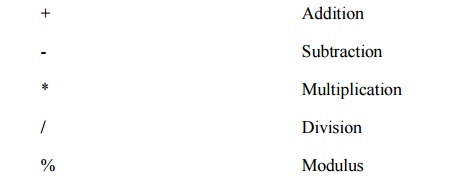OPERATORS
Verilog has large number of operators.
1. Binary Arithmetic Operators
Binary arithmetic operators operate on two operands. Register and net (wire) operands are treated as unsigned. However, real and integer operands may be signed. If any bit is unknown ('x') then result is unknown.
2. Operator Name

3. Relational Operators
Relational operators compare two operands and return a logical value, i. e., TRUE(1) or FALSE(0). If any bit is unknown, the relation is ambiguous and the result is unknown.
Operator Name
> Greater than
>= Greater than or equal
< Less than
<= Less than or equal
== Logical equality
!= Logical inequality
4. Logical Operators
Logical operators operate on logical operands and return a logical value, i. e., TRUE(1) or FALSE(0). Used typically in if and while statements. Do not confuse logical operators with the bitwise Boolean operators. For example , ! is a logical NOT and ~ is a bitwise NOT. The first negates, e. g., !(5 == 6) is TRUE. The second complements the bits, e. g., ~{1,0,1,1} is 0100.
5. Bitwise Operators
Operator Name
! Logical negation
&& Logical AND
|| Logical OR
Bitwise operators operate on the bits of the operand or operands. For example, the result of A & B is the AND of each corresponding bit of A with B. Operating on an unknown (x) bit results in the expected value. For example, the AND of an x with a FALSE is an x. The OR of an x with a TRUE is a TRUE.
Operator Name
~ Bitwise negation
& Bitwise AND
| Bitwise OR
^ Bitwise XOR
~& Bitwise NAND
~| Bitwise NOR
6. Unary Reduction Operators
Unary reduction operators produce a single bit result from applying the operator to all of the bits of the operand. For example, &A will AND all the bits of A.
7. Unary Arithmetic Operators
Operator : Name : Comments
- : Unary Minus : Changes sign of its operand.

